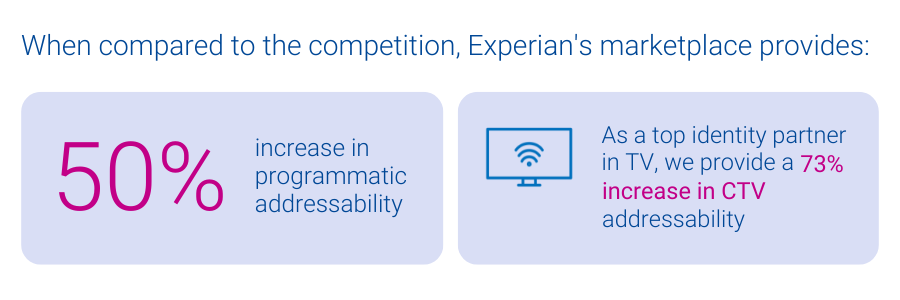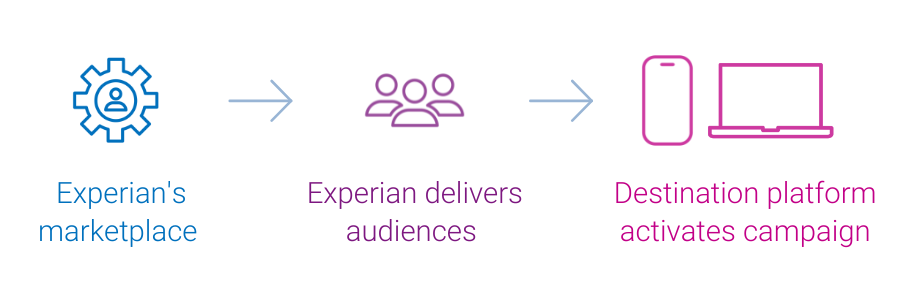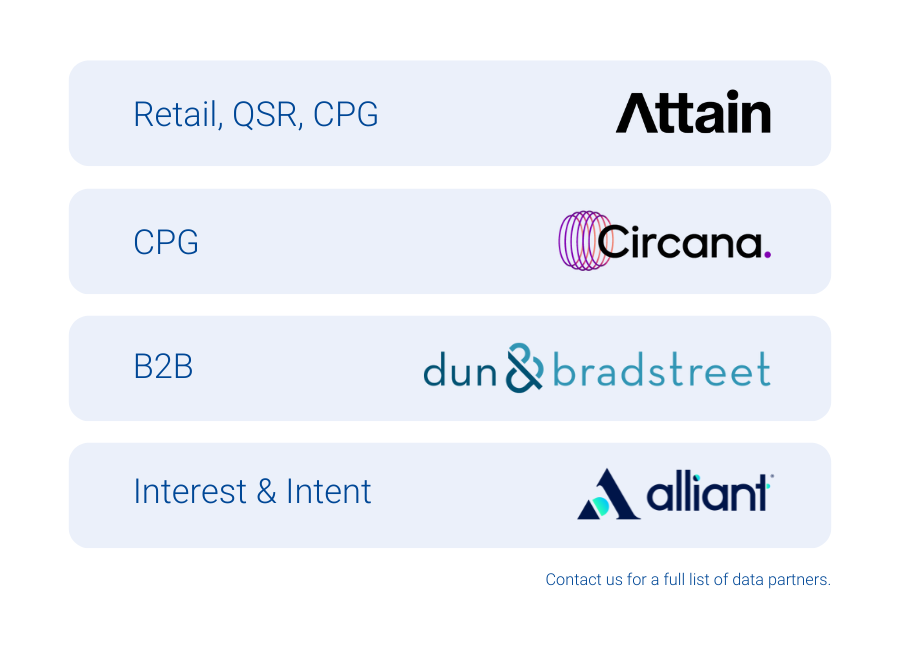
Following the success of our recent launch of Third-Party Onboarding, we are excited to introduce the Experian marketplace, a new addition to our portfolio of data-driven activation solutions.
Experian’s marketplace bridges TV operators, programmers, supply partners, and demand platforms with top-tier third-party audiences across retail, CPG, health, B2B, and location intelligence. Easily activate premium audiences from leaders like Attain, Alliant, Circana, and Dun & Bradstreet – driving precise, efficient consumer reach.
“Experian has been a longstanding partner of DISH Media, and we’re excited to be an early adopter of their marketplace which leverages the foundation of their identity solutions to ensure maximum cross-channel reach as we look to expand the breadth and depth of data we use for addressable TV.”
Kemal Bokhari, Head of Data, Measurement & Analytics, DISH Media
As privacy regulations evolve and traditional identity signals shift, many activation platforms face declining addressability. This impacts their ability to effectively reach consumers, which is critical to staying competitive. Experian’s marketplace, powered by our identity graphs which include 126 million households, 250 million individuals, and 4 billion active digital IDs, enables audiences to be easily activated and maintain high addressability across display, mobile, and connected TV (CTV) channels.


Benefits of Experian’s marketplace
- Enhanced addressability and match rates: All audiences delivered from our marketplace benefit from our best-in-class offline and digital identity graphs, which ensure addressability across all channels like display, mobile, and CTV. Unlike other data marketplaces, Experian ensures all identifiers associated with an audience have been active and are targetable, improving the accuracy of audience planning.
- Simplified audience planning and distribution for TV Operators: TV operators can build custom audiences matched directly to their subscriber footprint and distribute them across all advanced TV channels (data-driven linear, addressable, digital, and CTV) for maximum impact.
- Diversification within the data marketplace ecosystem: With the recent departure of Oracle’s advertising business, the optionality for buyers and sellers to connect with third-party data has become increasingly limited. With Experian marketplace, we’re excited to offer a new solution to the market that ensures data-driven targeting can continue to take place at scale.
- Lower activation costs: Experian’s marketplace offers transparent, pass-through pricing with no additional access fees, enabling partners to maximize their earnings while reducing costs.
- Audience diversity and scale: Platforms can access a broad range of audiences across top verticals from our partner audiences, which can be combined with 2,400+ Experian Audiences. This offers the flexibility, reach, and scale necessary to effectively execute advertising campaigns.
- Remove compliance concerns: Experian’s rigorous data partner review ensures available audiences comply to all federal, state and local consumer privacy regulations.
“Circana and Experian have enjoyed a deep partnership for over a decade. We are exceedingly excited to extend our partnership and be an early adopter and launch partner of the Experian data marketplace. This additional capability will enable the ecosystem to more easily access Circana’s purchase-based CPG and General Merchandise (for example Consumer Electronics, Toys, Beauty, Apparel etc.) audience segments to drive performance outcomes across all media channels.”
Patty Altman, President, Global Solutions, Circana

“Capturing the attention of target audiences across channels is critical for marketers navigating an increasingly connected digital world. We are excited to be an exclusive provider of B2B solutions within Experian’s marketplace, helping brands and media agencies to accelerate their reach, addressability and targeting capabilities across TV, mobile and connected TV channels.”
Georgina Bankier, VP of Platform Partnerships at Dun & Bradstreet
Better connections start here: Experian’s marketplace
Experian’s marketplace, easily accessible from our Audience Engine platform, brings unparalleled addressability, enabling our clients to reach more relevant consumers and increase revenue.
If you’re interested in learning more about Experian’s marketplace or becoming an active buyer or seller in our marketplace, please contact us.
Latest posts

With all the debate and speculation regarding Groupon and its planned IPO, I thought it would be a great time to check back in with our previous analysis of traffic to Groupon and its nearest competitor Living Social. First, to be clear, the above chart measures web-based traffic to both domains and does not include mobile or app specific traffic. Regardless of these exclusions, the drop-off in Groupon traffic this summer has been significant nearly 50% since its peak in the second week of June 2011 compared to last week. During the same time, Living Social has achieved 27% growth in visits to its site. Overall visits to a custom category of Daily Deal & Aggregator sites were down 25% for the same time. So why is there a narrowing of the gap between the two market leaders in group coupons? Perhaps it is simply a case of increased number of competitors and deal fatigue among consumers or simply not enough of the right deals. PriceGrabber® released results from its Local Deals Survey in June, stating that 44% of respondents said they use or search daily deal Websites. However, 52% expressed feeling overwhelmed by the number of bargain-boasting emails they receive on a daily basis. While consumer fatigue may be one factor another key consideration for these sites is to focus on the attracting new and preferred audience segments via the inbox. Currently the audience segments for both Groupon and Living Social are very similar so it will be interesting to see how both sites and category perform heading into the holiday season.

Newton was only half right: Objects in motion tend to stay in motion, but objects at rest are increasingly becoming mobile. That’s the case, at least, when it comes to the world of today’s mobile consumer. According to exclusive research from Experian Simmons, fully 29% of cell phone owners today believe that their cell phone will be the primary device for their entertainment needs, in the future. Furthermore, a recent report by J.P. Morgan estimates that U.S. mobile ad spending will nearly double in 2011 to $1.2 billion. Screen size and limitations on creative, the report says, present obstacles to mobile advertisers. These obstacles and opportunities make it more important than ever for marketers to understand the behaviors and mindset of the mobile consumer. In this first in a series of blog posts, we will explore some key findings presented in the 2011 Mobile Consumer Report recently published recently by Experian Simmons. Media outlets have started to take note, citing the report in articles here and here. Come back to this blog frequently for further updates, or download the full report today. Mobile Market Overview Cell phone ownership among American adults stands at 91%, up from 72% in 2006. The vast majority of teens, too, have joined the mobile revolution, with 74% of those ages 12 to 17 porting a portable phone, up from 59% in 2006. Even tots are getting into the act, with a reported 22% of kids ages 6 to 11 owning a cell phone today. Among adults ages 22 to 24, the idea of not owning a cell is virtually unheard of, with an astounding 98% of consumers in this bracket reporting personally owning a cell phone. While cell ownership among adults age 65+ is the lowest of any adult segment, it is the fastest growing, having increased a relative 52% between 2006 and 2010. Despite the rise in youth owning cell phones, 90% of all mobile phone owners in the U.S. are adults, a rate unchanged since 2008. Percent of Americans that own a cell phone, by age Mobile Service Providers Verizon maintains its position as America’s number one cell phone service provider, with 32% of all adult mobile phone owners saying they are Verizon subscribers as of May 23, 2011. AT&T also has a sizable share of the market, with 28% of mobile phone owners subscribing to AT&T for cell service. Battling for third place are Sprint and T-Mobile, which respectively claim just 11% and 10% of the mobile market. Smaller, often regional, providers may individually have fewer subscribers, but combined, claim an impressive 22% of the total cellular market. Verizon and AT&T will almost certainly continue to dominate the market, especially given the fact that cell phone subscribers are increasingly staying with their provider for an extended period of time. As of May 23, 2011, the average cell phone subscriber had been with their provider for 3 years and 2 months, up from 2 years and 11 months observed at the beginning of 2008. Furthermore, 59% of cell phone subscribers say they’ve been with their current provider for at least 4 years, up from 46% who reported the same in early 2008. 59% of cell phone subscribers say they’ve been with their current provider for at least 4 years Service Providers’ Share of Cell Phone Subscribers Click here to learn more about obtaining vivid consumer research from Experian Simmons and don’t forget to check back here for new blog posts on mobile consumers.

The popularity of flash sale websites with limited time & inventory offerings have grown exponentially over the two years. Online shoppers’ love for the thrill of snagging designer clothing, home décor, travel and even wine have caused visits to the category to increase 368% in July 2011 as compared to the same month two years ago and 109% one year ago. So far in 2011, Nordstrom acquired HauteLook, Amazon entered the fray with MyHabit and recently Saks Fifth Avenue announced the launch of a dedicated flash sale website after offering sale events per week on Saks’ main website. In July 2011, Zulily.com, a website offering sales targeted for women and babies/kids, captured the highest market share of visits at 16%, followed by Ideeli and LivingSocial Escapes. Amazon’s MyHabit ranked 11th, out of the 87 websites in the custom category after only 2 months in operation. Several of the major players over the past six months, the total visits to Ideeli increased 42%, Gilt.com up 14% and Nordstrom’s Hautelook up 8% for July 2011 as compared to February 2011. Total visits for MyHabit jumped 128% for July 2011 as compared to May 2011 when the website launched. The audience for Flash Sales continues to be attractive, and willing to shop – over-indexing against the online population for household incomes over $100k and creditworthy VantageScores of A and B.